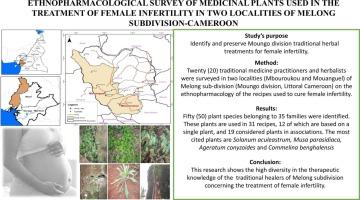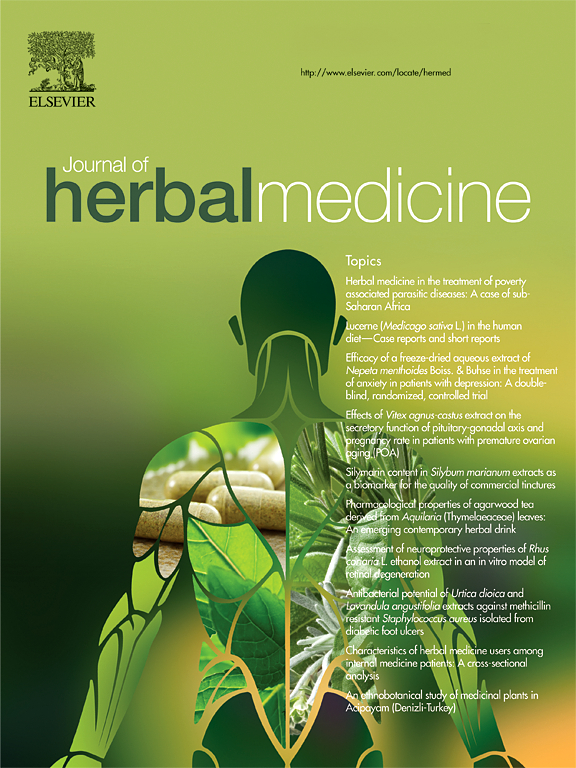喀麦隆梅龙分区两个地区治疗女性不育症药用植物的民族药理学调查
IF 1.9
4区 医学
Q2 INTEGRATIVE & COMPLEMENTARY MEDICINE
引用次数: 0
摘要
传统不孕症治疗的稀缺和传统医学知识的侵蚀构成了重大挑战。本研究旨在记录和保存蒙戈师治疗女性不孕症的草药,利用丰富的祖先治疗实践遗产。方法对喀麦隆沿海梅龙分区Mbouroukou和Mouanguel地区20名传统医师进行民族药理学调查。一份结构化的调查问卷收集了基于植物的治疗数据,并辅以对这些植物的植物学和治疗特性的全面文献综述。结果共鉴定出35科50种植物,应用于31种配方中。这些配方中大多数(19个)组合了多株植物,而12个是单株植物制剂。叶是最常用的植物部位(37.15%),汤剂是主要的制备方法(55.20%)。水是最常用的溶剂(75.85%),治疗主要通过肛门途径进行(54.84%),在不同的治疗持续时间内,每天的剂量从1到12个清洗球不等。值得注意的是,被采访者提到最多的植物是龙葵(Solanum acleastrum)、寄生木(Musa parasidiaca)、鹰嘴藤(Ageratum conyzoides)和板栗(Commelina benghalensis)。结论梅龙分区传统医师对女性不孕症的治疗知识具有丰富的多样性。承认和整合这种民族植物学知识对于保护药用植物物种和优化旨在改善妇女生殖健康结果的治疗干预措施至关重要。本文章由计算机程序翻译,如有差异,请以英文原文为准。

Ethnopharmacological survey of medicinal plants used in the treatment of female infertility in two localities of Melong subdivision-Cameroon
Introduction
The scarcity of conventional infertility treatments and the erosion of traditional medicinal knowledge pose significant challenges. This study aims to document and preserve herbal remedies of Moungo’s division against female infertility, leveraging the rich heritage of ancestral healing practices.
Methods
An ethnopharmacological survey was conducted on twenty traditional healers in Mbouroukou and Mouanguel, localities of the Melong sub-division (Littoral-Cameroon). A structured questionnaire collected data on plant-based treatments, supplemented by a comprehensive literature review on the botanical and therapeutic properties of these plants.
Results
The survey identified 50 plant species belonging to 35 families, utilised in 31 recipes. The majority of these recipes (19) combined multiple plants, while 12 were single-plant preparations. The Leaf was the most commonly used plant part (37.15%), with decoction being the primary preparation method (55.20%). Water was the mostly used solvent (75.85%) and treatments were predominantly administered via the anal route (54.84%), with dosages ranging from one to twelve purge bulbs per day over various treatment durations. Notably, Solanum aculeastrum, Musa parasidiaca, Ageratum conyzoides, and Commelina benghalensis were the plants most frequently mentioned by the interviewees.
Conclusion
The study reveals a rich diversity of therapeutic knowledge among traditional healers in Melong subdivision for treating female infertility. Acknowledging and integrating this ethnobotanical knowledge is essential for the conservation of medicinal plant species and the optimisation of therapeutic interventions aimed at improving women's reproductive health outcomes.
求助全文
通过发布文献求助,成功后即可免费获取论文全文。
去求助
来源期刊

Journal of Herbal Medicine
INTEGRATIVE & COMPLEMENTARY MEDICINE-
CiteScore
3.90
自引率
0.00%
发文量
94
期刊介绍:
The Journal of Herbal Medicine, the official journal of the National Institute of Medical Herbalists, is a peer reviewed journal which aims to serve its readers as an authoritative resource on the profession and practice of herbal medicine. The content areas of the journal reflect the interests of Medical Herbalists and other health professionals interested in the clinical and professional application of botanical medicines. The objective is to strengthen the research and educational base of herbal medicine with research papers in the form of case studies, original research articles and reviews, monographs, clinical trials and relevant in vitro studies. It also publishes policy statements, opinion pieces, book reviews, conference proceedings and profession related information such as pharmacovigilance reports providing an information source for not only the Herbal Practitioner but any Health professional with an interest in phytotherapy.
 求助内容:
求助内容: 应助结果提醒方式:
应助结果提醒方式:


